Artificial intelligence and hydrogen engine: the South Korean “Armata” project from Hyundai
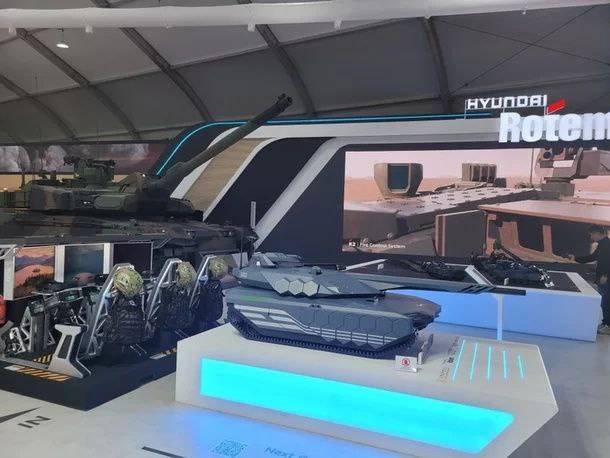
At the ADEX 2023 arms exhibition recently held in Seoul, Hyundai Rotem demonstrated the concept of a promising tank a new generation, which in the future may become a replacement for the Black Panther currently in service in the South Korean army. It seems that the creators were able to fit everything possible into their project, from an uninhabited tower with a new gun to a hydrogen engine and artificial intelligence.
It may seem strange that the Koreans are generally showing increased interest in new tanks, given the presence in their army of the very modern K2 “Black Panther”, which has not yet had time to tarnish its reputation in military conflicts to finally become convinced of its futility. But the question that in the foreseeable future it will have to be replaced with something has been asked by senior military officials from Seoul for a long time. And judging by media reports, the Koreans intend to come up with something to replace the Panther by the end of this decade or the beginning of the next very seriously.
While the process of determining the characteristics and appearance of the future tank is, as they say, at the stage of creative search, which is why it is impossible to find at least some specifics in this matter. However, just a couple of weeks ago, Huyndai Rotem, being the main tank builder of South Korea, presented its vision of a new tank, which may be the basis for the creation of a future combat vehicle.
Of course, we are talking about a model, and the project itself does not even have its own name, other than the simple abbreviation Next Gen MBT (NG MBT), which translated means “next generation main battle tank.” Nevertheless, with a quick inspection, based on some of the announced features of the promising tank, one can get some idea of the ideas of its creators.
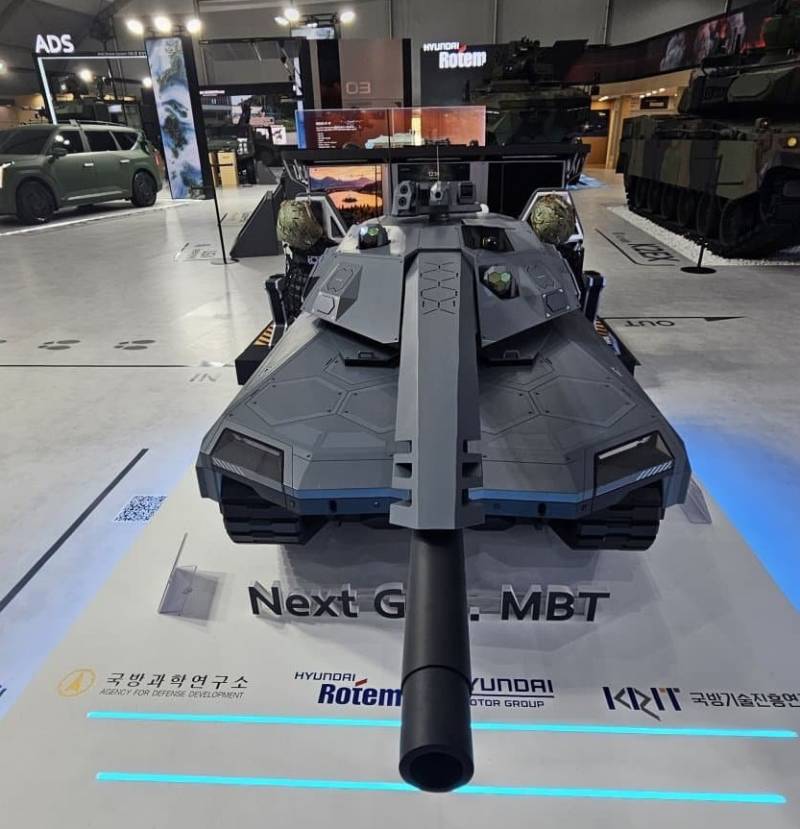
Next Gen MBT
And first of all, it is worth noting the non-standard layout of this concept model. Unlike existing production tanks, the South Korean project provides for the presence of a completely uninhabited turret and an isolated compartment for a crew of three in the bow of the hull, as has already been implemented on our T-14 Armata.
In general, such solutions in the design of combat vehicles were previously viewed with great distrust: the requirements for electronics and automation of equipment to equip such tanks are too high.
However, reducing the internal volume of the turret and its dimensions by transferring the crew into the hull is one of the few options that can seriously reduce and subsequently more efficiently use the mass of the combat vehicle through a more rational distribution of armor. Moreover, the location of tankers in a single compartment makes it possible to protect them as much as possible from damage by anti-tank weapons. Well, the uninhabited tower itself is a convenient platform for integrating everything that the customer desires: from a gun of the required caliber to launchers for drones or rockets.
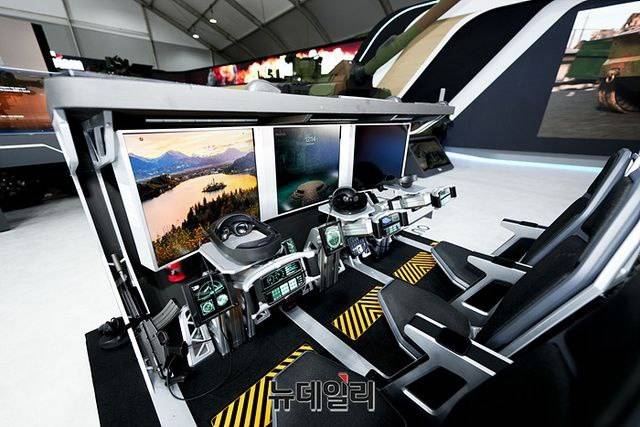
Next Gen MBT Crew Workplace Layout
So the South Korean “Next Gene” in this case is not a simple fantasy of designers and a tribute to fashion, but a completely viable option for a combat vehicle of the future.
They plan to arm the NG MBT with a 130-mm smoothbore gun with a fully automated loading cycle. This decision is completely justified, since the currently widespread 120-mm caliber has reached the limit of its capabilities and has already exhausted the reserve of modernization in terms of increasing muzzle energy, which is especially critical in terms of the development of new kinetic projectiles.
To some extent, a new weapon of this caliber is a golden mean.
On the one hand, an increase of just 10 millimeters gives an increase in muzzle energy by almost 50% and opens up new horizons in the creation of more powerful ammunition, including high-explosive fragmentation.
On the other hand, unlike the 140-mm Western guns, which US and European tank builders have been eyeing for a long time, such changes do not entail a radical increase in the weight and dimensions of transportable ammunition.
The only question is whether the Koreans will create a 130-mm gun on their own or take as a basis the German product demonstrated last year as part of the KF51 Panther project. Although in the case of borrowing a German gun, it will still need to be modified for an uninhabited turret with the introduction of diagnostic electronics - monitoring the condition of the artillery system, including recoil systems, is necessary, even when the crew is in an isolated compartment.
As for additional weapons, Hyundai engineers provided a remote-controlled 12,7-mm machine gun and a launcher for anti-tank missiles with homing capability built into the turret, which, if desired, can be replaced with a launcher with kamikaze drones. And reconnaissance of targets and monitoring the situation on the battlefield, as planned, will be carried out by a reconnaissance quadcopter.
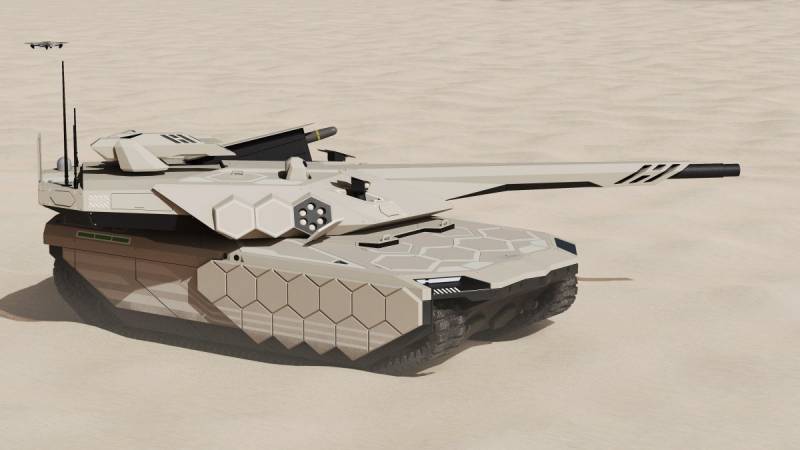
Render with Next Gen MBT equipped with active/reactive armor, missile launcher and reconnaissance drone
They don’t say anything intelligible about the fire control system, but they boast about the future introduction of elements of “artificial intelligence” that will help tankers in battle. This topic is not new - similar systems are already being tested in the USA (ATLAS) on Abrams tanks and in Israel (modernized Makhshev Mesima) on Merkava Barak. The essence of the work of these complexes is to search and identify targets using neural network algorithms that collect information both from the tank’s sights and observation devices, and using automated command and control systems from friendly units.
Analyzing the received data, the on-board computer provides the commander and gunner with coordinates and images of the most dangerous objects, and also suggests a projectile that is appropriate for effectively hitting the target, automatically generating all the corrections necessary for an accurate shot. In general, the help is good.
They plan to increase the protection of the future tank not only through passive armor. In this aspect of ensuring the high combat effectiveness of the vehicle, the Korean developers decided to go all-in and introduce everything they could into the vehicle.
NG MBT will be equipped with means of reducing visibility for reconnaissance radar stations and infrared surveillance devices (thermal imagers) due to stealth technologies - both with the help of special coatings and structural elements, including side screens that maximally block the heat-loaded chassis from view .
In addition, the tank’s arsenal includes electronic warfare equipment to suppress communication channels of enemy drones, dynamic protection and an active countermeasures system that destroys projectiles dangerous to the vehicle even on approach before contacting the armor. The latter is a familiar active protection complex (APS). And the mere presence of such a system on any tank does not look like an innovation at all. But, given the uninhabited turret, the introduction of all KAZ equipment into its design allows us to completely get rid of the problems with overweighting the tank, increasing its dimensions and protecting the elements of the complex from fragments and other damaging elements.
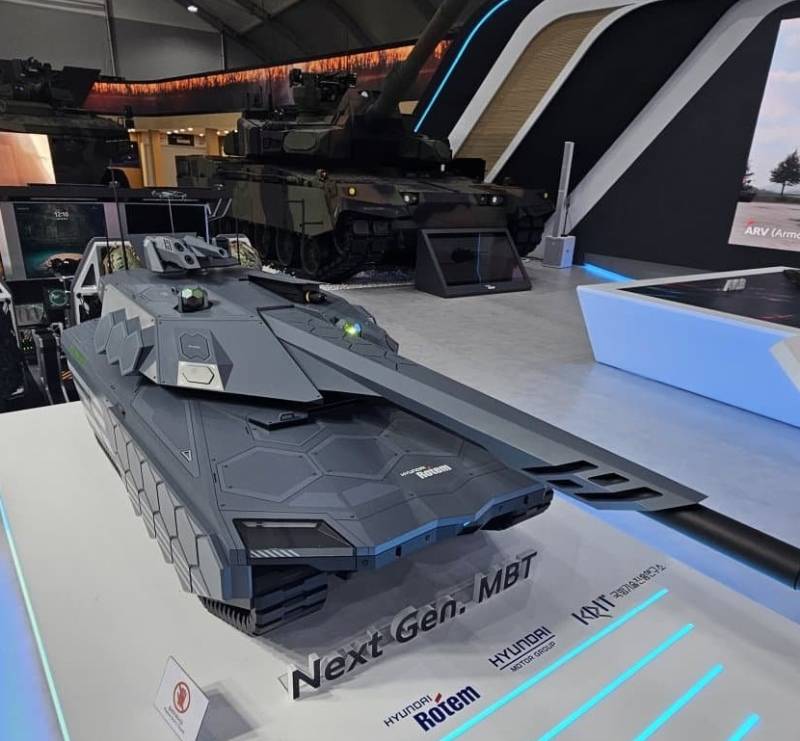
In terms of the engine, the NG MBT's innovations are no less grandiose than in terms of the tank's layout and armament. Still, the diesel engines and gas turbines that exist today are far from being the standard for fuel efficiency and, accordingly, the “logistics tail” trailing behind tank units. Therefore, since the task is to create a tank of the future, these issues should be given attention.
Following this trend, the gentlemen from Hyundai allow the presence of a diesel-electric hybrid power plant in the new tank. They say that you can drive either in mixed mode or in separate mode, using diesel fuel or the charge accumulated in the batteries. But the main goal of the engineers is to equip their brainchild with a hydrogen engine.
The hydrogen system, of course, has nothing in common with an internal combustion engine. In fact, this is a variation of the same electric traction, where the source of electrical energy is the chemical reaction of hydrogen and oxygen in a fuel cell. It consists of an anode (where hydrogen is supplied from the cylinders) and a cathode (with oxygen from the external air intake), an exchange membrane between them and the catalyst. The contact of these chemical elements causes an intense exchange of positively and negatively charged particles, and the output produces the necessary electricity and water vapor.
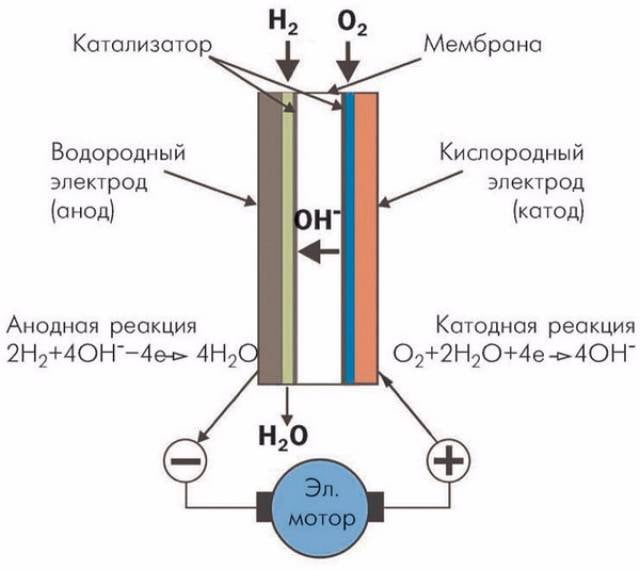
The steam is dissipated, and the generated electric current goes to electric motors, which drive the tracks.
As a result: completely silent operation of the tank, high driving performance and a large power reserve using hydrogen cylinders, which in principle cannot be provided by any of the common types of fuel.
But there are clearly a lot of problems, and the high cost of producing a tank with such an engine is far from the only one. For example, hydrogen cylinders, unlike tanks with traditional fuel, are extremely explosive, and their refueling (or replacement) creates additional difficulties in supplying combat units and deprives the combat vehicle of the ability to operate on several types of fuel, narrowing the range to one, completely inapplicable for other equipment.
So the guys from Hyundai will have to think carefully about how to implement this innovation without subsequent headaches for operators and suppliers. Although, it is worth recognizing that this matter is unlikely to end successfully.
But overall, as a concept, the tank looks quite attractive and contains those solutions without which a future combat vehicle is unlikely to be possible at all. At a minimum, this concerns the layout, armament and provision of neural network algorithms. But everything, as they say, is the will of the military - they operate the tank, which means they decide what is needed in it and what is not. And, according to Hyundai, the corresponding work with them is now underway, and time will tell what “Next Gen” will be like in the end.
Information